Mostly Computer Science-related topics and resources, especially Linux and education (IB, IGCSE).
Saturday, 5 December 2009
Mousey Terminal
It's called GPM.
According to Wikipedia (short and sweet description), GPM means "general purpose mouse" and it "provides mouse support in Linux virtual consoles. It is included in most Linux distributions."
If you want to know more, this is GPM's official page.
Saturday, 28 November 2009
Sitex 2009
Sunday, 8 November 2009
Day 1 with Snow Leopard
ioreg -l -p IODeviceTree | grep firmware-abi
| | "firmware-abi" = <"EFI64">
sudo nano /Library/Preferences/SystemConfiguration/com.apple.Boot.plist
Kernel mach_kernel Kernel Flags arch=x86_64
arch=x86_64
uname -a
Darwin xxxxxxx 10.1.2 Darwin Kernel Version 10.1.2: Wed Sep 9 23:09:02 PDT 2009; root:xnu-1486.1.8~1/RELEASE_X86_64 x86_64
defaults write com.apple.dock no-glass -boolean YESkillall Dock
defaults write com.apple.dock no-glass -boolean NOkillall Dock
sudo installer -package /Volumes/Microsoft\ Office\ 2008/Office\ Installer.mpkg/ -target /
Applications > Utilities > Adobe Utilities > Adobe Updater
Monday, 2 November 2009
Unbuntu 9.10 Released!
Great news! Ubuntu 9.10 was released at the end of October, and it's the best Ubuntu yet! Try it for free or get more information at:
So far I've tried it and it's looking and working better than ever!
If you have an MSI Wind U100 or similar netbook, you may want to know that the brightness glitch can easily be fixed (at the time of this post) by disabling the 3D desktop effects. At least that worked for me.
Thursday, 22 October 2009
Windows 7
Tuesday, 22 September 2009
Google+Education
Best Free Defragmenter
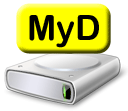
A must have piece of software for any Windows user:
MyDefrag - download and install it!
First run may be slow. Use it often (recommended: weekly or every other week) for better results.
Twitterholics
Are you into Twitter?
If so, this blog entry with 11 Free Twitter clients may be interesting to you.
This post has similar information, specifically for Linux: "Six Twitter clients for the Linux desktop and one for the road".
Personally, I use the web interface when posting, and/or Twitterrific (available for the iPhone or as a desktop Mac application.
You may also want to check Tweetie for Mac OS X and MyTweeter for Windows.
The nice and glossy icon used in this post is from AODdesign!Saturday, 19 September 2009
Premiere Elements 6
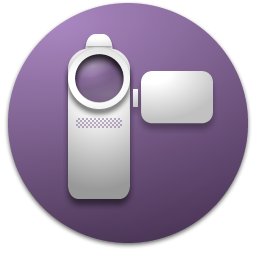
I had to work intensively with Adobe Premiere Elements 6 last weekend. It became a horrible experience since it crashed often.
Obviously, I had to find an immediate solution. After a lot of google, more gray hair and frustration, I found the bug: Microsoft's Visual C++ runtime is pure fertilizer and must be updated.
Download and install these two files, but mind the fact that the smart people of M$ named them... Exactly the same. So change the names or save to different folders. Anyway, applying these updates solved my crashing problem in Premiere Elements 6.
- Microsoft Visual C++ 2008 Redistributable Package (x86)
- Microsoft Visual C++ 2005 Redistributable Package (x86)
I installed both just to make sure there are no conflicts and both are up-to-date. Should the links stop working because of M$ changing them, just google for their names and get them from Microsoft.com.
If you're looking for the best and least expensive Photoshop & Premiere you can get, check this great bundle by Adobe.
All brand and product names, logos, etc. belong to their respective owners, blah, blah, blah...
Monday, 10 August 2009
Annoying Firefox settings
These are the simple steps to change FF's default settings:
Go to Firefox > Preferences
and then, under the Main tab,
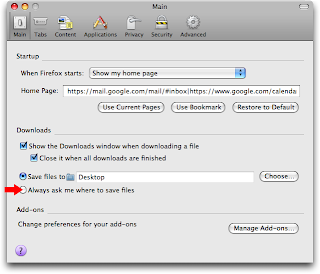
click on "Always ask me where to save files"
Monday, 3 August 2009
OpenOffice.org
Downloading OpenOffice.org takes too long?
Try a server near you - the list is here.
For example, the two South Korean servers that mirror OpenOffice.org are
Friday, 31 July 2009
LXDE and Ubuntu
There's a concise article in Spanish at BolivarLUG with information plus screenshots. Summarising, runs acceptably on a PentiumII (192MB RAM), well on a PentiumIII, and very fast on an AMD Athlon 1.6 (the last two with 512MB RAM).
The only problem, if you have a laptop or connect to a network wirelessly, is that LXDE may not start the Network Manager by default. This solution was tried and tested on Ubuntu 9.04 and worked flawlessly.
You need to use the terminal. Of course ;-)
cd /etc/xdg/lxsession/LXDE/All you need to do is add the following line at the end of the file:
sudo nano autostart
@nm-appletthen press CONTROL X, press Y, and ENTER/RETURN. Log out and back on, and you're all set.
The only way I've found to add icons to the desktop (don't have much time to play with these things, sorry) is to copy the .desktop file(s) from the /usr/share/applications/ folder (corresponding to the application you want) to your home folder's Desktop folder.
Using the terminal, this would be an example:
cd /usr/share/applications
ls
cp gnome-terminal.desktop ~/Desktop
More information on LXDE at:
Thursday, 30 July 2009
A fast and lightweight IDE
My favourite tool for coding (well, together KDE's KATE and Gnome's Text Editor).
It's Geany, a native Linux GTK2 application available to most distributions and ported to Windows as well.
Check its home on the web and download it!
Thursday, 16 July 2009
Linux counter and more
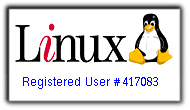 Yes, I'm a Linux user. If you are, too, have your machine(s) counted at the Linux counter.
Yes, I'm a Linux user. If you are, too, have your machine(s) counted at the Linux counter.My favourite distro is Ubuntu (easy guess, probably), although I prefer KDE (still a fan of version 3.5) over Gnome. I like Gnome, Xfce, and LXDE, as well, Linux = choice and that's why I am so fond of it.
Other distros I like are Sidux, Mandriva (One), and openSuse and Fedora, in that order of preference.
Other sites you should know, related to Linux of course, are distrowatch and tuxradar.
New to Linux? Read this article on choosing the right distro for you.
Wednesday, 15 July 2009
64 bit mania
Especially after an encouraging success with Ubuntu 9.04 (64-bit), I got the itch again.
I found these interesting and useful web sites:
The frist one, called start64.com, which I'm reading now. It has information regarding 64-bit technology for Vista, Windows 7, and also Linux.
Second, this article at Tomshardware.com, which explains things you should know about Windows, 32 vs 64 bit. If you want to skip the details, at least read the article's conclusions.
Third, Microsoft itself. They have a "Windows Vista Compatibility Centre", a one-stop databse where you can check whether your hardware and software is compatible with Windows or not. Just check the 64 bit option and you're all set. Check the screenshot below for reference.
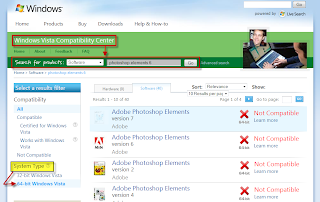
GarageBand-like applications for Windows
If you have ever used GarageBand (included with iLife, from Apple), but are a Windows user, you probably would like something similar that you could use in your Windows PC at home...
Fortunately, there are alternatives such as:
- Acid Xpress (free, but you also have to download loops to make it work)
- Music Maker --trials only-- (classic & premium) by Magix
- Cakewalk's Music Creator (no trial available)
- and Acid Pro by Sony (trial)
Tuesday, 14 July 2009
Fixing PC
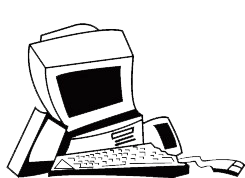
I've been really busy taking my desktop PC apart and putting it back together after my Windows Vista -_- installation got corrupted and wouldn't boot any more.
Tried repairing it using the Vista install DVD ~ no luck.
FYI, I tried the methods described at neosmart.net and bleepingcomputer.com.
So ended up replacing motherboard, SATA cables, and checking for greener (less power demanding) components. Video cards may end up consuming far too much power nowadays, and I don't think most of us need them.
Now everything is back to normal, and I suspect that the problem was a malfunctioning/broken SATA connector on the motherboard.
Oh, well, at least it's fixed, over and done now.
Wednesday, 8 July 2009
Linksys routers
It's happened to me ever since I got my first router. The more stupid passwords I have, the more I forget. Maybe it's one of Murphy's laws?
Anyway, the easy answer is reset the router. Find the reset button, press it for 30 seconds, and it's all back to factory defaults.
For Linksys/Cisco routers, head to their website to grab their manuals (usually PDF format) and firmware ("ROM") updates.
I've also had Dlink network hardware in the past, so here's their support/downloads link.

Wednesday, 28 January 2009
Fedora 10
I'm going off-topic. Back to Fedora 10, the boot/start up time is impressive, I can't tell you the exact number of seconds, but it makes Ubuntu feel like a tortoise in comparison. Looks neat, works fast, very good software selection even if you don't customise it (I went for the default + development packages).
Anything bad? I wish I could have more control over which repositories to use in order to add and update the software. I've been spoiled by Debian, Ubuntu and their derivatives, yes... And perhaps a tool like the restricted drivers utility/install wizard, like the one Ubuntu includes, would make things easier.
Otherwise and so far, superb distro. I just wish it had tools to make my life easier in terms of optimisation, as I mentioned in the previous two paragraphs. I don't think I'll have enough time for another post on Fedora 10 anytime soon, but if you have the time and you like to try something different than the Ubuntu crowd of distros, have a look at Fedora. It's worth your time, in my opinion.
Linux on USB flash drives
The tools you need:
- UNetbootin
- the ISO image of your distribution of choice
A last piece of advice: try to stick to the "Default" boot option of the UNetbootin boot loader. Trying a couple of distros with other options messed things up and the distro couldn't finish booting. Had to restart (CTRL+ALT+DEL) and try the default option.
Another valuable source is http://www.pendrivelinux.com/ ; do check it out if you want to learn more about putting Linux on pen/flash/usb drives! ;-)
Sunday, 25 January 2009
New to Mac OS X
The purpose of this post isn't to review or criticise the platform or the OS, but to help you if you're new to Apple Macs and OS X, like I once was.
Hope you will find these links useful. I was trying to find Mac OS X version 10.4 "Tiger" resources, but there are links to Mac OS X 10.5 "Leopard" as well.
(videos)
- http://www.vtc.com/online-tutorials/Mac-OS-X-10.4-Tiger-tutorials.htm
- http://movies.atomiclearning.com/k12/osx_tiger_orientation
- http://www.youtube.com/watch?v=UGVHKl0CCCE
- http://www.apple.com/findouthow/mac/
(tutorials, text+images)
- http://www.apple.com/support/osfamily/ (support for Apple's Operating Systems & software - main link)
- http://www.apple.com/support/leopard/ (everything that Apple as for the 'Leopard' 10.5 system is here)
- http://www.apple.com/support/tiger/ (everything that Apple as for the 'Tiger' 10.4 system is here)
- http://www.inspectmygadget.com/2007/08/21/mac-os-x-taming-the-tiger-a-guide-for-beginners-part-1/
- http://www.apple.com/support/mac101/ (this tutorial shows the newest system 'Leopard', very similar to 'Tiger' - there will be minor differences, though)
- http://guides.macrumors.com/Mac_Beginner's_Guide (collection of links)
- http://support.apple.com/kb/HT2477 (some essential info. on the system)
- http://osxhelp.com/ (more tutorials)
Optimise Windows 10/11
How to optimise your Windows setup Just in case you need it. If you want a safe and conservative approach, just disable the background apps ...
-
Lenovo Ideapad S10-3 If you have a Lenovo Ideapad S10-3 (depicted above), and you want to test or install shiny new Ubuntu 10.10 on it,...
-
In order to program in Java, you may want to follow the instructions and videos that I have prepared. They are simle and straightforward, an...
-
This brief post shows how to create a bi-dimentional array and describe it using IB pseudocode. It isn't stated in the IB Pseudocode in ...

